“It was a real learning experience,” she recalls, “to sit for hours with great paintings and get inside an artist’s head to see the logic of how he put the painting together.” Reflecting upon earlier artists who have influenced her interpretation of the coastal landscape, Downing-White credits the Luminists but singles out the English painter John Constable (1776–1837) and the 17th-century Dutch painters. “It always comes down to Constable,” she says. “You can see through the paint. The whole experience of color and transparency, through to the ground pigment, looks beautiful. I also see that in the Dutch painters. Their work expresses mood so well. They are intense but quiet. Even in thunderstorms, they have that feeling for me.”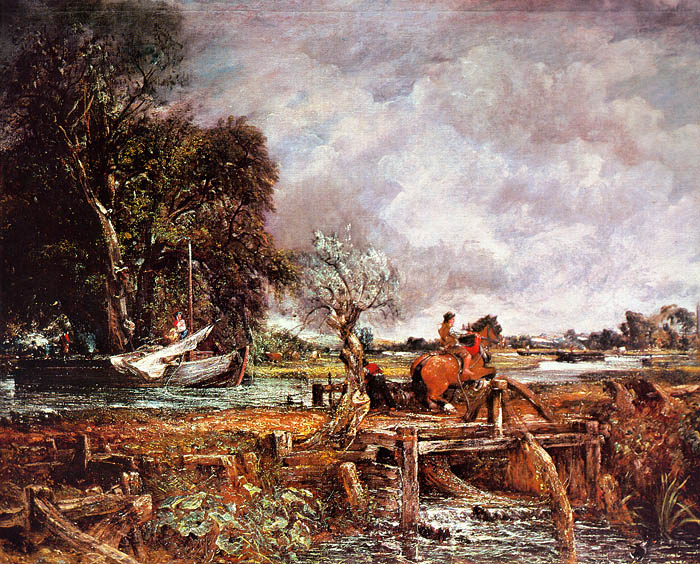
- “The essential difference is that Constable retained to the last his sound foundation in monochrome. Paintings like The leaping Horse, The Valley Farm and The Cenotaph, with all their splashing and spotting and scraping and loading have thus a certain unity and dignity, which enables them to hang by the side of the paintings of the old masters, without looking garish or undecided. . . . It is only necessary to compare his work with that of his predecessors or contemporaries, to realize how vast was the revolution that he initiated, more especially in the matter of colour, which he treated with a combination of frankness and temperance as yet unsurpassed.”
Initially, the Royal Academy was quite reluctant to accept Constable as a member with full honors. They set the standards for what was acceptable as art, and the clientele was drawn mainly from the middle class not that dissimilar to the Salon painting in France. Academy clients termed his work ”low” art and his brushwork was generally held to be offensive. For the life of them, they could not understand the logic; it was in fact incomprehensible, why anyone would pay hard earned money for a picture of a barn, a mill, or a laborer. What was popular were large theatrical pieces, glittering scenes and action filled dramas. This eagerness for glossy miracles of technique and pictorial novelty was equally shocking to Constable who regarded them as pathologically depraved.
“His earlier efforts, modest, quiet, and aiming only at a simple realism, passed unnoticed on the exhibition walls; and when, later on, his powers developed, and his portrayal of nature grew more vigorous and vivid, his pictures were subjected to much abuse and scornful criticism. His recognition by the Royal Academy was tardy. Many of the Academicians still regarded landscape as a minor branch of historical painting only worthy of consideration when it aimed at the “grand style.” He was elected an Associate when thirty-three years of age, and had to wait for ten years longer before full honours were accorded him.”

Constable. The Valley Farm."No man has hitherto combined so much of that beauty of aspect which we all admire in the Art of the past, with so large a measure of the wind and sunshine which have become the conditions of the painting of our own day. Had Constable carried realism further, it might have been difficult to claim so much for him."
Fortunately for Constable, this period saw the foundation of another long-lasting friendship. Friendships with John Dunthorne and Sir george Beaumont had each led to remarkable extensions of his art, and now, a chance meeting with Dr. Fisher, the rector of Langham, led to the friendship that was to sustain him to the long days of rejection ahead.
The parish of Langham lay to the south of Dedham Vale, and it was on a hill not far from Langham Church that Constable sat to draw his favorite view of the river scenery below. Dr. Fisher liked to make watercolor sketches of the same lovely farmland. After he became bishop of Salisbury, Fisher invited Constable to visit him there. Constable was to find a scene he would make almost as famous as Flatford Mill; the tall, pale, dizzily spired cathedral rising out of the water meadows and the sluggish river, the kind of river he liked, winding over Salisbury Plain. And there, too, in 1811, he was to meet the wisest, most understanding person in his life: John Fisher, the bishop’s nephew and a newly ordained minister as well.
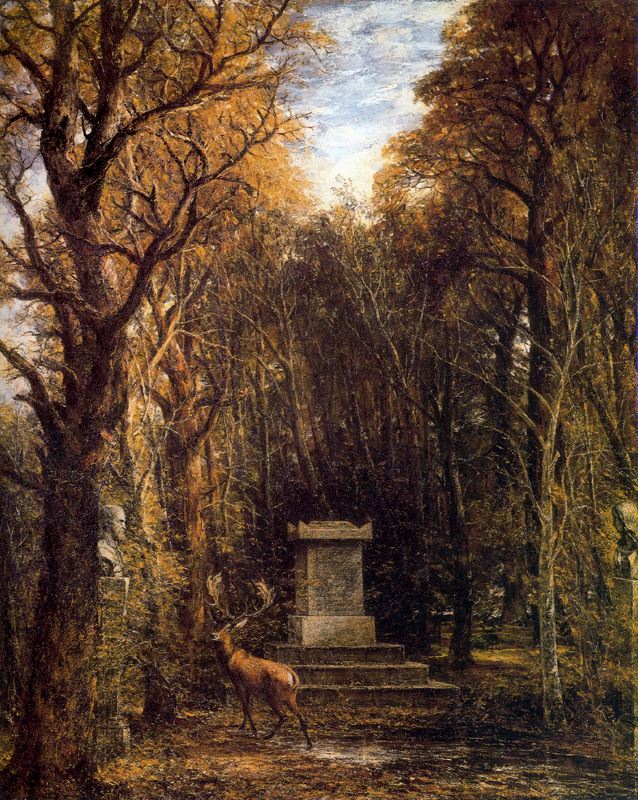
"We also feel calmer and more secure in a warm environment. This is why warm paintings out-sell cool paintings. Good examples of cool, green, blue landscapes can be found in the works of English artist John Constable, who painted on a burnt red/brown toned surface. His work influenced the Barbizon School of French landscape painting which became the foundation of plein air painting as we know it today."
Constable spent these formative years not only in discovering “his path”; he was also busy doing all the things other young artists of the time did. He showed paintings of the fashionable Lake District at the Royal Academy, and he entered into the spirit of the Napoleonic Wars by going to Chatham and painting H.M.S. Victory, May, 1803. Superb sea painter that Constable was, with an expert knowledge of shipping, he found the sea itself formless and horrifying. He never sought it out. His magnificent sea pictures were nearly all painted when chance circumstances brought him within sight of the ocean.
Although Constable was at the height of his powers between the years 1810 and 1818, particularly with his “Boat-building Near Flatford Mill, painted entirely in the open air during the summer of 1815, it was not until the end of that decade that he set out to force the public to accept him as an important landscape artist. His aim was to produce for the academy a number of very large pictures of Flatford Mill and Dedham Vale that would incorporate both his scientific view of nature and a remarkable new painting technique. The canvas size was deliberate, calculated to impress the Academy and test himself: “a large canvas will show you what you cannot do, a small one will only show you what you can do.” He called this venture his “canal” pictures, and the series was undertaken during what were probably the happiest years of his life. …
“I am planning a large picture,” … “and I regard all you say, but I do not enter into that notion of varying one’s plans to keep the public in good humour. Change of weather and effect will always afford variety. What if Vander Velde had quitted his sea-pieces, or Ruysdael his water-falls, or Hobbema his native woods? The world would have lost so many features in art. I know that you wish for no material alteration, but I have to combat from high quarters—even from Lawrence—the plausible argument that subject makes the picture. Perhaps you think an evening effect might do; perhaps it might start me some new admirers, but I should lose many old o
I imagine myself driving a nail; I have driven it some way, and by persevering I may drive it home; but quitting it to attack others, though I may amuse myself, I do not advance beyond the first, while that particular nail stands still. No man who can do any one thing well will be able to do any other different thing equally well; and this is true even of Shakespeare, the greatest master of variety.”
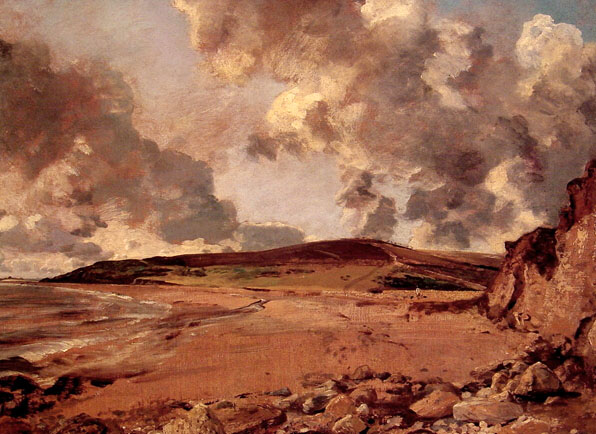
Constable. Weymouth Bay." Constable painted the scenes in which he took the most delight. " I love every stile and stump, and every lane in the village," he writes in 1799, "so deep rooted are early impressions;" and that feeling remained with him throughout life. It is not true that he could not draw; even a casual acquaintanceship with the innumerable studies he made for his pictures, particularly of trees and clouds, is sufficient to show the unfairness of such a statement, based, no doubt, on insufficient data. The "necessary details" of his pictures were purposely neglected by him in order that he might concentrate his efforts upon the rendering of what were to him higher and more important truths. The accusation of want of reverence in approaching nature would have been laughed at as absurd by those who knew him intimately."
… The basis of this happiness was his marriage to Maria Bicknell. She was the granddaughter of Dr. Rhudde, rector of East Bergholt, a fierce, rich, authoritarian old man who seems to have distrusted Constable long before the artist met Maria. The dislike was so obvious that when the two fell in love they lived in dread of the rector”s finding out about their relationship and disinheriting Maria. The lovers were forced into a miserable and frustrating secrecy that Constable found particularly distressing. He was thirty-three when this secret courtship began and thirty-nine when the wise John Fisher persuaded the unhappy couple to stop worrying about Dr. Rhudde’s money and get married.
John Fisher himself had been married a few months earlier, to Wordworth’s niece, and now the four of them left London by coach for a honeymoon in Dorset, bringing Constable to one of his chance meetings with the sea, and to the subject of his most profound sea painting, “Weymouth Bay”.
On their return from the honeymoon, the Constables set up housekeeping in London, and Constable began traveling to Suffolk to make oil sketches for pictures he later painted in his studio in town. It is these oil sketches that contain the essence of his genius. In them, we see art entering a new dimension. Executed entirely for his own instruction and joy, they are masterpieces that fuse the elements of the natural scene; light, earth and water.
Other painters had sketched their first ideas in oils rather than pencil or chalk, but none like Constable. Something unique and amazing happened here. A moment of time in the open air was transposed to canvas, or to the specially prepared sheets of paper he often used. Constable once said, “If i were bound with chains I should break them, and with a single hair round me i should feel uncomfortable.” In these tremendously immediate paintings, each a complete statement in itself, he found the total artistic freedom he needed.
In the six “canal” pictures of 1819 to 1825, which grew out of these sketches, Constable combined his inspired vision of landscape with, he hoped, sufficient traditional feeling to make the canvases acceptable to the public, and particularly to the artists at the Royal Academy. But his colors hadn’t been blended properly, people said, and the white flecks of paint he used as highlights were dismissed as “Constable’s snow.”
“The aspect under which he painted English scenery was a new one. Until his time the ordinary practice had been for the artist to paint with the sun behind him, out of the picture, low down on the horizon, suffusing the whole landscape with a golden haze, producing those effects which Claude and Cuyp rendered so finely. Constable, on the other hand, liked better to work with the sun high above his head, out of the canvas, but still in front of him ; and painted almost always under the sun. This was one of the chief causes of the earlier adverse criticism of his pictures, as his point of view was too novel to be thoroughly understood, or, at least, appreciated by those who had been taught to regard the more usual method as the only artistic way of rendering sunlight in landscape.
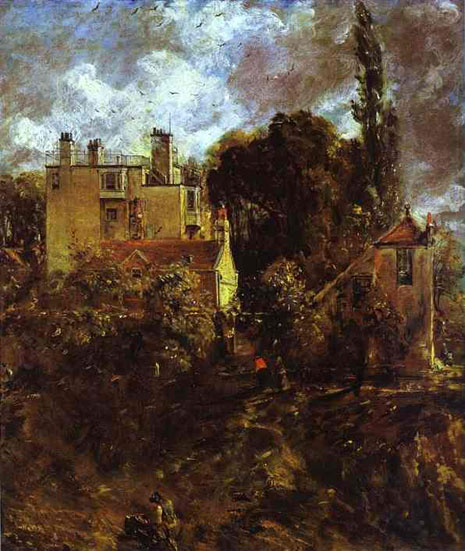
Constable. The Admiral's House 1820-1823."Constable painted this from the upper window of his house at a Lower Terrace. It depicts a property remodeled by a retired admiral. He called the main roof his quarterdeck and celebrated special occasions by firing cannons in salute. Ten years later Constable exhibited a painting of this subject titled 'A Romantic House at Hampstead'."
Constable’s greatest peculiarity in their eyes, which arose largely from this habit of his, was the sparkle and glitter of white lights upon his foliage. This they laughed at as spotty, splashy, and meaning-less, and nicknamed it “Constable’s snow.” He adopted the use of spots and points of pure white paint as the best method at his hand by which to render the bright light which all foliage, especially after rain, reflects from its countless surfaces, when seen between the spectator and the sun. As he grew older this brightness and sparkle, which he saw more and more on all sides, made still greater appeals to him; but his point of view was not immediately understood.”
“The Hay Wain” completed in 1821, was the third canvas in the series to fail to find a buyer at the Royal Academy. it was hanging in a gallery called the British Institute when two young leaders of the French Romantic movement, Théodore Gericault and Charles Nodier, saw it and were overwhelmed.



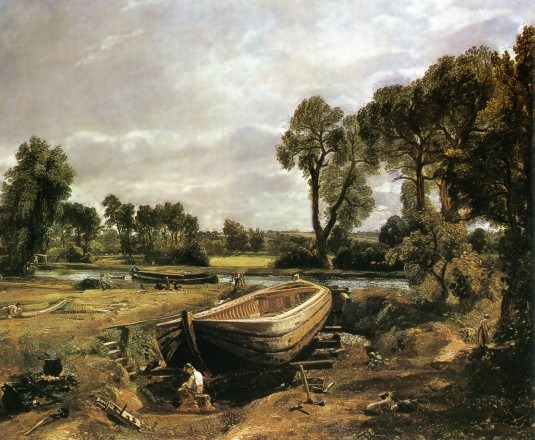







 COMMENTS
COMMENTS



